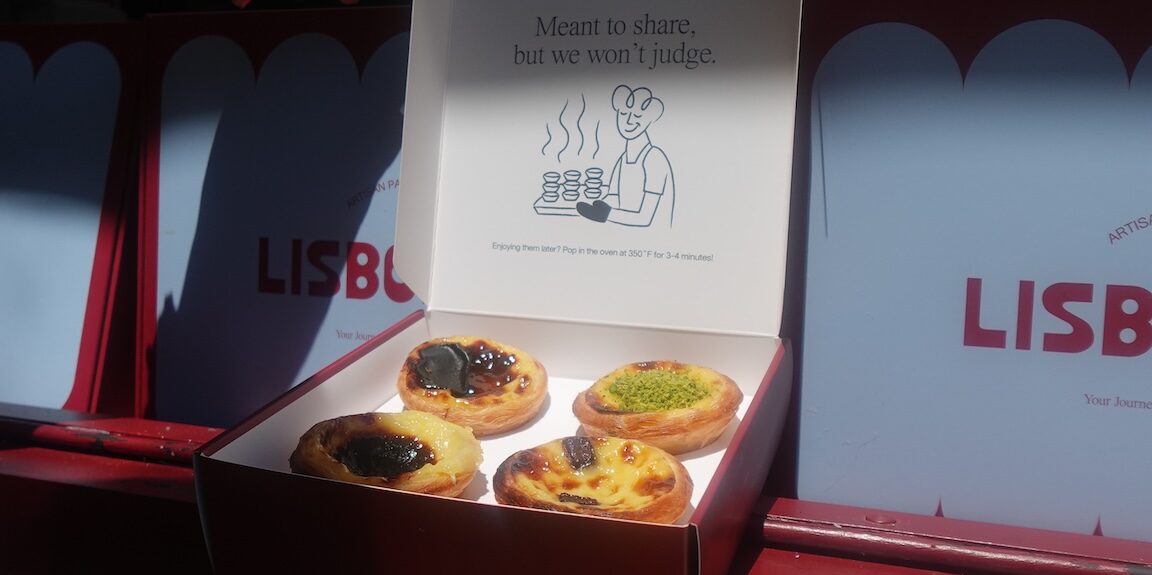Business Lifestyle & Culture
Mixing old and new at a Portuguese bakery
By Sienna de Silva
Businessmen in navy suits slowed their brisk pace, craning their necks and looking over their shoulders as they passed the hole in the brick wall on Saint Johns Place where bakery workers take customers’ orders and pass them sweet treats.
Like those businessmen glancing backwards to read the menu placard screwed to Lisbonata’s front wall, a woman walking her dog turned her head to peer into Lisbonata bakery’s glass showcase of bright yellow custard cups. The custard cups, called pastèis de nata, originated in Portugal, whose capital city is Lisbon.
“One big thing,” said Catherine Cirzan, a barista at Lisbonata, is “there is not a lot of Portuguese representation nearby.”
The population of Brooklyn’s Crown Heights neighborhood, home to Lisbonata, is 6.7% Asian, 12.6% Hispanic, 27.4% white and 45.5% Black.
There may be a simple reason that some of those people’s heads turn when they pass by the walk-up window. “They’ve been coming to try something new,” said Cirzan, referring to Lisbonata’s diverse customers.
“A mix of people,” said Cirzan, come to try Lisbonata’s specialty, Portuguese custard cups. Most of them are getting their first taste, so Cirzan suggests the traditional lemon- and vanilla-flavored custard as an introduction.
Lisbonata’s minimalistic design also tries to conjure a European vibe. It’s plain white building with the plaster finish, with dark red accents, also mirrors places in Lisbon.
“Pastéis de Nata, Coffee, Goods.” reads the knee-high white sign on the corner of Saint Johns Place that first caught Emily Liu’s eye. Seeing the maroon and white lettering of the sign, with a cartoon baker in the center, she said, “This place looks cute. So I was, like, ‘Oh, my God, I want to try it.’”
Craving some sweets, Sandie Green stopped by Lisbonata to buy custard cups for a different reason: “I’m a caramel freak.” She held a palm-sized pink and burgundy box of the original, raspberry and salted caramel custard cups to try for the first time with her girlfriend.
“But we definitely going to come back,” she said, to try the other Belgian chocolate and pistachio flavors.
There’s also custards made of pistachios and yuzu, a Chinese citrus fruit. Those are not traditional custard ingredients. They are trendy, part of Lisbonata’s “mix of old and new,” Cirzan said, that entices people to return.
“It’s, like, a New York improvement” on Portuguese custard cups, said Bobby Vinson, a local customer who has been to Portugal. The variety of flavors, he said, are “another level up, I would say, from the roots.”
Vikram Dishor, who also lives in the neighborhood, said, “This is the most authentic and the only place where you can get the pastèis de nata.”
Dishor, who said he and his girlfriend traveled to Portugal, likes how the pastries remain authentic, even though the flavors are new.
Eating them also takes him back to his childhood. His mother, said Dishor, who was born in India, made a mixture of Jell-o and custard that was firmer than the natas.
Emily Liu, an immigrant from China, sees Lisbonata’s custard cups as a variation of the Chinese egg tarts she grew up eating. Although the Portuguese version has a different taste, she loves Lisbonata’s “creative flavors that you don’t really see anywhere else.”
When Portuguese customers try Lisbonata’s rendition of the iconic pastry, “it feels … special,” Cirzan said.
In her experience serving Portuguese patrons, they feel “connected to Portugal” through the pastries, and often arrange for their immigrant parents to come try them.
“This is a very different vibe than, like, other places in the neighborhood,” Cirzan said. “So, people have been coming to just try something new.”


